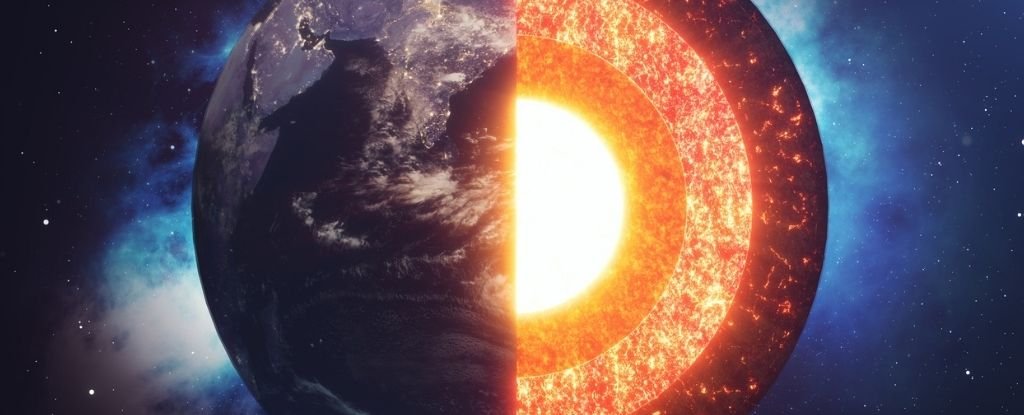Products You May Like
When seismic waves speed through the body of our planet, they appear to travel 3 percent faster when moving vertically from pole to pole, than horizontally from east to west.
New models suggest this is because Earth’s solid core is growing faster on one side, deep beneath Indonesia’s Banda Sea, and slower on the other side, underneath Brazil.
Once, there was a time when our planet didn’t have a solid core. The deepest interior of our planet probably held a mass of molten material for billions of years before liquid iron in the center began to cool and solidify.
This means Earth’s very center could be a giant, growing cluster of crystallized iron, and when these crystals align in a certain way, it probably allows seismic waves to travel faster in some directions.
Running models on how this particular alignment might have occurred, researchers have stumbled across an unexpected explanation: Earth’s inner core is growing in a lopsided way.
“The simplest model seemed a bit unusual — that the inner core is asymmetric,” says global seismologist Daniel Frost from the University of California Berkeley.
“The west side looks different from the east side all the way to the center, not just at the top of the inner core, as some have suggested. The only way we can explain that is by one side growing faster than the other.”
It’s impossible to drill down into Earth’s inner core to check what’s going on, so this is an area of research ripe for debate. The propagation of seismic waves and computer simulations are some of the only ways we can test possible explanations for why our planet is formed like it is.
Using various computer models that account for Earth’s geodynamics and the physics of iron minerals under high pressure and temperature, researchers have now attempted to figure out why our planet’s inner core is aligned in such a particular way.
The simplest explanation they found was that our world’s crystal core is growing fastest at its equator and on the east side in particular.
“This corresponds to a growth rate that is 40 percent lower at the poles and 130 percent larger at the Equator compared with the global average,” the authors conclude.
“The growth rate at the equator varies between the eastern and western hemispheres from 100 percent to 160 percent of the global average rate, respectively.”
This asymmetric growth rate suggests some parts of Earth’s inner core are warmer, while other parts are cooler, allowing iron crystals to form at a faster rate. Gravity then spreads this excess growth evenly in the soft yet solid core, keeping the shape spherical overall and driving crystals toward the north and south poles.
Ultimately, researchers explain, it is this movement via gravity that aligns the crystal lattice of Earth’s inner core along the rotation axis of our planet.
And so it has been from the very start. The model indicates this type of asymmetric growth has been occurring since the planet’s interior first started to cool and solidify, growing in radius by a millimeter per year on average.
If the model is accurate and that is the true rate of growth, it means Earth’s solid inner core is a relatively recent phenomenon, only showing up between half a billion and 1.5 billion years ago, but probably on the younger side.
That’s confusing because Earth’s magnetic field is at least 3 billion years old, and this field is thought to be formed when heat from the crystallization of iron in the inner core boils up molten material in the outer core.
If Earth’s core really is this young, then it could mean our planet’s magnetic field was not always generated in the same way.
Some scientists, for instance, have suggested the original magnetic field was much weaker than it is now and was created by dissolved light elements, pooling at the outer edge of our planet’s inner core.
Only when those elements began to crystallize, researchers argue, did the magnetic field grow stronger. Seismic waves propagating throughout the crystal core then induced the electromagnetic field we know today.
Even from the movements of tiny crystals deep in our planet’s core, big forces can grow.
The study was published in Nature Geoscience.
